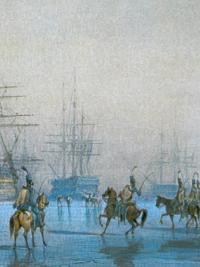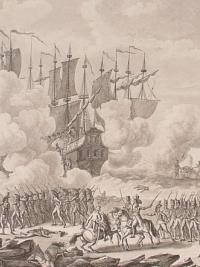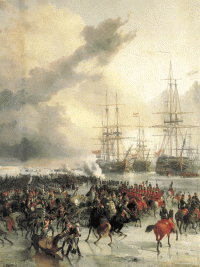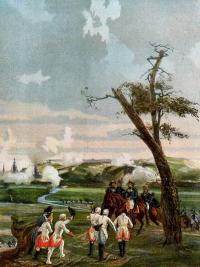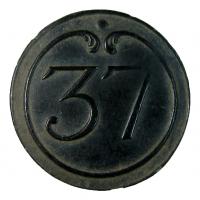Армия Королевства Голландия 1804-1810 годов - Army of the Kingdom of the Netherlands 1804-1810
Армия Королевства Голландия 1804-1810 гг
Государство, которое сейчас называется Нидерландами (в русскоязычной среде распространено также неофициальное название – Голландия, по-французски страна называется Les Pays-Bas) возникло в 1794 году под именем Батавской республики.
Оно образовалось когда войска революционной Франции прошли через Австрийские Нидерланды (современную Бельгию) и вторглись на территорию которая в наше время принадлежит Нидерландам.
Одним из самых знаменательных и известных эпизодов в этой компании был захват французской кавалерией всего голландского флота, который вмерз в лёд у острова Тексель.
До присоединения Королевства Голландии к Франции на протяжении 1806-1809 годов армия королевства принимала участие в следующих кампаниях:
- Фридланд, 14 июля 1807 года;
- Капитуляция Гамельна, 7-22 ноября 1807 года;
- Блокада Штральзунда, 15 января-20 августа 1807 года.
В Испании:
- Альмонасид, 11 августа 1808 года;
- Сьодад Реал,27 марта 1808 года:
- Месса де Ильбор,17 марта 1808 года;
- Оканья,18-19 ноября 1808 года:
- Талавера,27-28 июля 1808 года;
- Сорноса,30 октября 1808 года.
Кроме того, голландская армия в 1809 году участвовала в подавлении восстания Шилля, а также в штурме Штральзунда 31 мая 1809 года.
Одним из главных преимуществ голландских солдат была их малая восприимчивость к заболеванию малярией. Дело в том, что эта болезнь была сильно распространена в прибрежных районах их родины, поэтому у местных жителей выработолось нечто вроде иммунитета. Эта особенность голландцев в чстности помогла при захвате острова Вальхерен.
Вальхеренская экспедиция (Expedition Walcheren)
В начале мая 1809 года Британия, вошедшая совместно с Австрией, Сардинией и Сицилией, в составе Пятой антифранцузской коалиции, принялась готовить экспедицию против Зеландии (La Zelande) - одной из провинций Нидерландов.
Союзники планировали путём вторжения пяти дивизий в Голландию оттянуть силы французов от основного театра военных действий в Германии, разгромить французский флот (10 линейных кораблей), базирующийся во Флессингене (Flessingue), захватить Антверпен (Anvers), где под руководством генерального комиссара флота Пьера-Виктора Малуе (Pierre-Victor Malouet) (1740-1814) шло активное строительство военных кораблей, уничтожить французские арсеналы на Шельде (Schelda) и поднять восстание местного населения против французов.
Экспедиционный корпус (35 000 человек) был отдан под командование генерала Джона Питта (John Pitt, 2nd Earl of Chatham) (1756-1835), старшего брата бывшего премьер-министра Уильяма Питта (William Pitt) (1759-1806).
Флотом экспедиции (40 линейных кораблей, 30 фрегатов, 90 бригов и канонерских лодок, 400 транспортов) командовал адмирал Страшан (Sir Richard John Strachan, 6th Baronet of Thornton) (1760-1828).
Флот двинулся к Зеландии 24 июля 1809 года и утром 29 июля прибыл к голландским берегам. После этого несколько фрегатов и сотня транспортов направились под командованием генерала Гордона (George Duncan Gordon, 5th Duke of Gordon, Marquess of Huntly) к Брекенсу (Breskens), остальные двинулись в направлении пляжа Бризанд (Breezand) на севере острова Вальхерен.
Вследствие слабости береговой обороны генерал Руссо (Antoine-Alexandre Rousseaux) (1756-1827), располагающий только 300 солдатами Национальной гвардии в Брекенсе, срочно запросил помощи из Гента (Gand).
Подкрепление прибыло в полдень 30 июля, после чего генерал Гордон отказался от штурма и решил присоединиться к главным силам у Вальхерена.
31 июля 18 000 британских солдат совершили высадку около лагеря Весткапелле (Westkapelle). Войска генерала Монне де Лорбо (Louis-Gabriel Monnet de Lorbeau) (1 200 человек), несмотря на храбрую оборону, были не в состоянии помешать десанту и отступили в крепость Флессинген.
В итоге 1 августа 1809 года англичане заняли Веере (Veere), а 2 августа высадились на остров Зюйдбевеланд (Zuidbeveland) где захватили административный центр Гоэс (Goes).
Итак, 6 августа 1809 года английский экспидиционный корпус приступил к осаде Флессингена. Гарнизон под командой генерала Монне совершил высадку 8 августа, но должен был отступить перед превосходящим в 10 раз врагом. В итоге стычки французы потеряли 800 человек, а английские потери составили 1500 солдат и офицеров.
13 августа портовый город Флессинген подвергся 42-часовой массированной бомбардировке. Несмотря на это, генерал Монне отверг предложение о сдаче, поэтому 15 августа началась повторная бомбардировка к которой подключились и ракетные установки.
На следующий день генерал Монне вынужден был подписать акт о капитуляции, по условиям которой французский гарнизон (4 000 человек) был с воинскими почестями отправлен в Англию.
Нужно отметить, что сдача Флессингена и Вальхерена вызвала гнев Императора. Военный совет (Conseil de guerre) после тщательного расследования обвинил Монне в трусости и измене, поэтому генерал был заочно приговорен к смертной казни.
К этому моменту Совет министров Империи (Conseil des ministres de l,Empire), возглавляемый Камбасересом (Jean-Jacques Regis de Cambaceres) (1753-1824), одобрил концентрирование сил в количестве 30 000 солдат Национальной гвардии пограничных отделов в Антверпене и поручил общее командование маршалу Бернадотту (Jean-Baptiste-Jules Bernadotte) (1763-1844). Он прибыл в Антверпен 6 августа 1809 года и сразу изолировал острова Вальхерен и Зюйдбевеланд, отрезав англичан от континента.
Однако, Император, недовольный тем, что командующим был назначен Бернадотт (маршал впал в немилость после после сражения при Ваграма (Wagram), приказал 11 сентября 1809 года заменить его маршалом Бессьером (Jean-Baptiste Bessieres) (1768-1813).
Назначенный маршал выбил англичан с острова Зюйдбевеланд и блокировал Вальхерен, после чего британский корпус оказался в изоляции. Влажный и болотистый климат острова породил эпидемию болотной лихорадки – за неделю из строя вышло более 10 000 солдат, не считая моряков (от болезни умерло 4 066 солдат и офицеров, тогда как военные потери составили всего 106 человек).
После объявления мира между Австрией и Францией, англичане эвакуировали Флессинген, разрушив построенный французами военный арсенал, а 9 декабря 1809 года последние британские части оставили Голландию.
Состав британского экспедиционного корпуса Вальхерена на 28 июля 1809 года:
Командование:
- Главнокомандующий: генерал Джон Питт (John Pitt, 2nd Earl of Chatham).
- Второй командующий: генерал Кут (Sir Eyre Coote).
- Начальник штаба: генерал Браунригг (Sir Robert Brownrigg).
Левое крыло:
- 1-я дивизия генерал-лейтенанта Креддока (Sir John Craddock);
- Бригада генерал-майора Грехэма (Sir Thomas Graham). 1-й, 35-й и 81-й пехотные полки).
- Бригада генерал-майора Хьюстона (Sir William Houston). 14-й, 51-й и 63-й пехотные полки.
- 4-я дивизия генерал-лейтенанта Фрезера (Alexander MacKenzie Fraser).
- Бригада бригадного генерала Брауна (Browne). 5-й, 23-й, 26-й и 32-й пехотные полки).
- Бригада генерал-майора Пиктона (Sir Thomas Picton) (36-й, 8-й, 77-й и 82-й пехотные полки).
Лёгкие войска:
- 9-й полк лёгких драгун бригадного генерала Магона (Mahon).
- 68-й, 71-й, 85-й лёгкие полки и две роты 95-го лёгкого полка бригадного генерала Роттенбурга (Francis de Rottenburg).
Правое крыло:
- Лёгкая дивизия генерал-лейтенанта Сен-Клера (James St. Clair-Erskine, 2nd Earl of Rosslyn);
- Бригада генерал-майора Стюарта (William Stewart). 43-й, 52-й лёгкие полки и 8 рот 95-го лёгкого полка.
- Бригада генерал-майора Линсингена (Linsingen). 3-й драгунский полк, 12-й полк лёгких драгун и 2-й гусарский полк Королевского Германского Легиона.
- Бригада генерал-майора Альтена (Adolph Viktor Christian von Alten). 1-й и 2-й лёгкие батальоны Королевского Германского Легиона.
- 2-я дивизия генерал-лейтенанта Гордона (George Duncan Gordon, 5th Duke of Gordon, Marquess of Huntly).
- Бригада генерал-майора Дайотта (Dyott).
6-й, 50-й и 91-й пехотные полки.
- Бригада бригадного генерала Монтрезора (Montresor).
9-й, 38-й и 42-й пехотные полки, рота 95-го лёгкого полка.
- 3-я дивизия генерал-лейтенанта Гросвенора (Sir Thomas Grosvenor).
- Бригада генерал-майора Лейта (James Leith).
11-й, 59-й и 79-й пехотные полки.
- Бригада бригадного генерала Акланда (Acland).
2-й, 76-й и 84-й пехотные полки.
- Резерв генерал-лейтенанта Хоупа (John Hope).
- Бригада бригадного генерала Диснея (Disney).
1-й и 3-й батальоны 1-го полка пешей гвардии, рота Колдстримской гвардии (Coldstream Guards) и 2-й батальон 3-го полка пешей гвардии.
- Бригада генерал-майора Эрскина (William Erskine).
20-й и 92-й пехотные полки.
- Бригада генерал-майора Ремзи (George Ramsay, 9th Earl of Dalhousie).
4-й и 28-й пехотные полки, рота 95-го лёгкого полка.
- Артиллерия бригадного генерала Маклеода (John Macleod).
- Королевская конная артиллерия (Royal Horse Artillery) капитана Макдональда (Alexander Macdonald).
- Роты пешей артиллерии (D,Arcy,s Brigade, Paterson,s Brigade, Campbell,s Brigade, Rogers,s Brigade, Brome,s Brigade, Drummond,s Brigade, Cleeve,s Brigade, Wilmot,s Brigade, Fyers,s Brigade, Marsh,s Brigade, Adye,s Brigade, Buckner,s Brigade, Oliver,s Brigade, Webber-Smith,s Brigade, Massey,s Brigade и Munro,s Brigade: всего 70 пушек, 74 мортиры и ракетные установки).
- Две роты инженеров.
- Три роты ездовых, 132 вагона, 238 телег.
6 000 лошадей.
После победы под Аустерлицем в декабре 1805 года, Наполеон назначил главой правительства Батавской республики своего младшего брата. На голландский трон взошёл Луи Наполеон, известный под именем короля Людовика.
Новый король Голландского королевства старался быть независимым от своего старшего брата. Нужды королевства были для него важнее задач, которые ставил ему Наполеон Бонапарт, ориентируясь на потребности Франции.
Так например, голландский флот, по требованию Наполеона, должен был восполнить потери Франции после разгрома при Трафальгаре, а войска должны были пополняться рекрутами из Голландского королевства.
Однако у короля Людовика находилось множество причин и отговорок для игнорирования "пожеланий" своего царственного брата. Закончилось всё вполне предсказуемо. В 1810 году Людовик Бонапарт вынужден был отречься от престола и Голландское королевство было присоединено к Французской Империи.
Голландская армия пополнила французскую и послужила основой многих полков, которые в составе Великой Армии участвовали в Русской Кампании.
Army of the Kingdom of the Netherlands 1804-1810
The State, which is now called the Netherlands (in the Russian-speaking community, is also common informal name – The Holland, in French this country is called Les Pays-Bas) was occurred in 1794 under the name of the Batavian Republic.
It was formed when the armies of revolutionary France passed through the Austrian Netherlands (modern Belgium) and invaded the territory that today belongs to the Netherlands.
One of the most important and well-known episodes of this company was the capture of the Dutch fleet by French cavalry. This fleet was frozen in the ice near the island of Texel.
The army of the Kingdom of the Netherlands took part in the following campaigns during 1806-1809 before joining France:
- Friedland, 14 July 1807;
- Surrender of Hamelin, 7-22 November 1807;
- Blockade of Stralsund, January 15-August 20, 1807.
In Spain:
- Almonacid, 11 August 1808;
- Sodad Real Madrid, 27 March 1808:
- Mass de Ilbor, March 17, 1808;
- Ocana, 18-19 November 1808:
- Talavera, 27-28 July 1808;
- Sornosa, October 30, 1808.
In addition, in 1809 the Netherlandish army took part in suppression of the insurrection of Schill, as well as in the assault of Stralsund on May 31st, 1809.
One of the main advantages of the Netherlandish soldiers was their low susceptibility to malaria. The fact was that the disease raged in the coastal regions of their country, so they had a sort of immunity. This feature of the Netherlandish helped in the capture of the island of Walcheren.
Valherenskaya expedition (Expedition Walcheren)
In early May 1809, Britain became a part of the fifth anti-French coalition together with Austria, Sardinia and Sicily. They began to prepare an expedition against Zealand (La Zelande) - one of the provinces of the Netherlands.
The allies planned to pull French forces off from the main theater of war in Germany by the invasion of five divisions to Holland. To defeat the French fleet (10 ships), that was based in Flessingene (Flessingue).To capture Antwerp (Anvers), where was an active construction of warships under the leadership of Commissioner General of the Navy Pierre-Victor Malu (Pierre-Victor Malouet) (1740-1814).To destroy the French arsenals on the Scheldt (Schelda) and turn the local population against France.
Expeditionary force (35 000 people) was given under the command of General John Pitt (John Pitt, the 2nd Earl of Chatham) (1756-1835). It was the older brother of former Prime Minister William Pitt (William Pitt) (1759-1806).
Expedition fleet (40 ships of the line, 30 frigates, 90 brigs and gunboats, transports 400) was commanded by Admiral Strachan (Sir Richard John Strachan, 6th Baronet of Thornton) (1760-1828).
The fleet moved toward Zealand on July 24th, 1809 and the in morning of July 29 it arrived to the Holland coast. After that, several frigates and a hundred of carriages was headed to Brekens (Breskens), being under the command of General Gordon (George Duncan Gordon, the 5th Duke of Gordon, Marquess of Huntly). The others moved in the direction of the beach Brizand (Breezand) in the north of the island of Walcheren.
Because of the weakness of the coastal defense, General Rousseau (Antoine-Alexandre Rousseaux) (1756-1827), who had just 300 of soldiers of the National Guard in Brekens urgently requested for help from Ghent (Gand).
Reinforcements arrived at noon on July 30th. After that General Gordon gave up on the idea of the assault and decided to join the main forces at Walcheren.
On July 31st 18 000 of British soldiers landed near the camp Westkapelle (Westkapelle). Despite the brave defense, the troops of General Monnaie de Lorbach (Louis-Gabriel Monnet de Lorbeau) (1,200 people) were unable to interfere the troops and retreated to the fortress Flessingen.
As a result, on August 1st, 1809 the British occupied Veere (Veere).On August 2nd they landed on the island Zyuydbeveland (Zuidbeveland) where they captured the administrative center of Goes (Goes).
So, on August 6th, 1809 British expeditionary corps began the siege of Flessingen. The garrison under the command of General Monnet made a landing on August 8th, but had to retreat. As a result, the French lost 800 people in the hassle, while the British losses were 1,500 troops and officers.
On August 13th the port city Flessingen underwent a 42-hour bombing. Despite this, General Monnet rejected the offer of surrender, so on August 15th there was the second bombing with rocket launchers.
Next day, General Monnet was forced to sign the act of surrender, under which the French garrison (4,000 people) was sent to England with full military honors.
It should be noted that the surrender of Flessingena and Walcher angered the Emperor. The Military Council (Conseil de guerre) accused Monnet of cowardice and treason after a thorough investigation. So general was sentenced to death.
At this point, the Council of Ministers of the Empire (Conseil des ministres de l, Empire), headed by Cambaceres (Jean-Jacques Regis de Cambaceres) (1753-1824), approved the concentration of powers in the amount of 30,000 of soldiers of the National Guard of border departments in Antwerp. Then the Council has entrusted the overall command to Marshal Bernadotte (Jean-Baptiste-Jules Bernadotte) (1763-1844). He arrived in Antwerp on August 6th, 1809 and immediately isolated such islands as Walcheren and Zyuydbeveland, cutting the British off from the continent.
However, the Emperor was displeased that Bernadotte (Marshall fell out of favor after the after the battle of Wagram (Wagram) was appointed as the commander. That’s why on September 11th, 1809 he ordered to replace him with Marshal Bessieres (Jean-Baptiste Bessieres) (1768-1813).
The appointed Marshal knocked out the British from the island of Zyuydbeveland and blocked Walcheren, and then British corps was isolated. Wet and swampy climate of the island has created an epidemic of swamp fever - a week of action more than 10,000 soldiers were killed by this disease. And it is if not to count the sailors (4066 officers and men died from illness, while military losses amounted to only 106 people).
After the declaration of peace between Austria and France, the British evacuated Flessingen, destroying the French-built military arsenal, and on December 9th, 1809 the last of the British left Holland.
Composition of the British Expeditionary Force of Walcher on July 28, 1809:
The command:
- Commander: General John Pitt (John Pitt, 2nd Earl of Chatham).
- The Second Commander: General Coote (Sir Eyre Coote).
- Chief of Staff: General Brownrigg (Sir Robert Brownrigg).
Left wing:
- The 1st Division Lieutenant General Craddock (Sir John Craddock);
- The Brigade of Major-General Graham (Sir Thomas Graham). The 1st, the 35th and the 81st Infantry Regiments).
- The Brigade of Major-General Houston (Sir William Houston). The 14th, the 51th and the 63th Infantry Regiments.
- The 4th Division Lieutenant General Fraser (Alexander MacKenzie Fraser).
- The Brigade of Brigadier-General Brown (Browne). The 5th, the 23rd, the 26th and the 32nd Infantry Regiments).
- The Brigade Major-General Picton (Sir Thomas Picton) (the 36th, the 8th, the 77th and the 82nd Infantry Regiments).
Light troops:
- The 9th regiment of light dragoons of Brigadier General Mahon (Mahon).
- The 68th, the 71th, the 85th light regiments and two companies of the 95th Regiment of the Light regiment of Brigadier General Rottenburg (Francis de Rottenburg).
Right wing:
- The Lightweight Division of Lieutenant General St. Clair (James St. Clair-Erskine, 2nd Earl of Rosslyn);
- The Brigade of Major-General Stuart (William Stewart).The 43th, the 52nd light regiments and 8 companies of 95th Regiment of Light.
- The Brigade of Major General Linsingena (Linsingen).The 3rd Dragoon Regiment, the 12th regiment of light dragoons and the 2nd Hussars King's German Legion.
- The Brigade of Major General Altena (Adolph Viktor Christian von Alten).The 1st and the 2nd light battalions of the Royal German Legion.
- The 2nd Division of Lieutenant General Gordon (George Duncan Gordon, the 5th Duke of Gordon, Marquess of Huntly).
- The Brigade of Major General Dayott (Dyott). The 6th, the 50th and the 91st Infantry Regiments.
- The Brigade of Brigadier General Montresor (Montresor).The 9th, the 38th and the 42th infantry regiments and a company of the 95th Regiment of Light.
- The 3rd Division of Lieutenant General Grosvenor (Sir Thomas Grosvenor).
- The Brigade of Major-General Leith (James Leith).The11th, the 59th and the 79th Infantry Regiments.
- The Brigade ofBrigadier General Ackland (Acland).The 2nd, the 76th and the 84th Infantry Regiments.
- The Provision of Lieutenant-General Hope (John Hope).
- The Brigade of Brigadier-General Disney (Disney). The 1st and the 3rd battalions of the 1st Regiment of walking Guard, the company of Coldstream Guards (Coldstream Guards) and the 2nd Battalion of the 3rd Regiment of the Guard walking.
- The Brigade of Major-General Erskine (William Erskine).The 20th and the 92nd Infantry Regiments.
- The Brigade of Major General Ramsey (George Ramsay, 9th Earl of Dalhousie).The 4th and the 28th infantry regiments and a company of the 95th Regiment of Light.
- The Artillery of Brigadier General McLeod (John Macleod).
- The Royal Horse Artillery (Royal Horse Artillery) of Captain MacDonald (Alexander Macdonald).
- The company of foot artillery (D, Arcy, s Brigade, Paterson, s Brigade, Campbell, s Brigade, Rogers, s Brigade, Brome, s Brigade, Drummond, s Brigade, Cleeve, s Brigade, Wilmot, s Brigade, Fyers, s Brigade, Marsh, s Brigade, Adye, s Brigade, Buckner, s Brigade, Oliver, s Brigade, Webber-Smith, s Brigade, Massey, s Brigade and Munro, s Brigade: a total of 70 guns, 74 mortars and rocket launchers).
- Two companies of engineers.
- Three companies of sled, 132 wagons, 238 carts, 6000 horses.
After the victory in Austerlitz in December 1805, Napoleon appointed his younger brother as the head of government of the Batavian republic. Louis Napoleon, known as King Louis, ascended the Holland throne.
The new king of the Kingdom of the Netherlands tried to be independent from his older brother. The needs of the kingdom were more important to him than the tasks that were supplied by Napoleon Bonaparte. So Louis focused on the needs of France.
For example, the Holland fleet was to make up the losses of France after the defeat in Trafalgar at the request of Napoleon, and the troops had to be replenished with recruits from the kingdom of the Netherlands.
However, Louis had a lot of reasons and excuses for ignoring the "wishes" of his royal brother. It all ended predictably. In 1810, Louis Bonaparte was forced to abdicate and the Kingdom of the Netherlands was annexed to the French Empire.
The Holland army has expanded the French army and had served as the basis of many regiments that participated in the Russian campaign as a part of the Grand Army.
There is currently no content classified with this term.
Social

